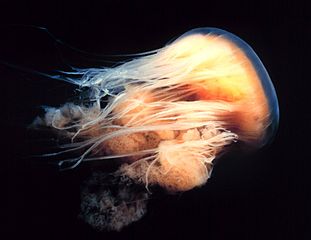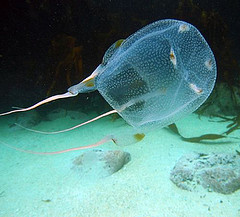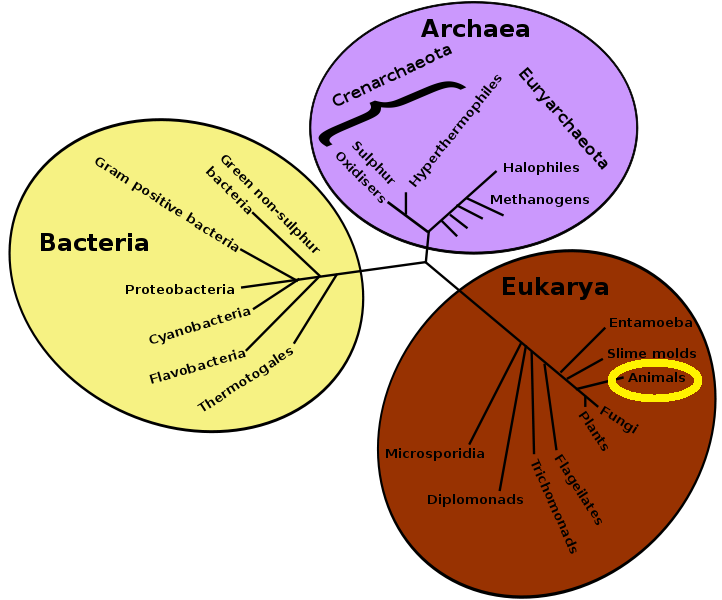Classification
Domain: Eukarya
Kingdom: Animalia
Phylum: Cnidaria
Class: Cubozoa
Order: Chirodropida
Family: Chirodropidae
Genus: Chironex
Species: Chironex fleckeri
 Domain Eukarya: This box
jellyfish is a eukaryote because its cells have membrane
bound organelles and a true nucleus. To learn about
another organism that is a eukaryote, visit the site all
about
Narcissus pseudonarcissus, commonly known as
the daffodil.
Domain Eukarya: This box
jellyfish is a eukaryote because its cells have membrane
bound organelles and a true nucleus. To learn about
another organism that is a eukaryote, visit the site all
about
Narcissus pseudonarcissus, commonly known as
the daffodil.
Kingdom Animalia: This box jellyfish is classified in the kingdom Animalia because it is heterotrophic and lacks a cell wall. This kingdom contains every animal on our planet! To see another animals check out the site all about Eciton hamatum, commonly known as the army ant, or Isonychia bicolor.
This phylogenetic tree represents the
placement of the Animal Kingdom relative to others in
the three domains on life. You can see it's closely
related to organisms such as Fungi and Slime Molds. Photo courtesy of Wikimedia
Commons. To see what a real fungus looks like, check out
Auricularia auricula-judae or
Galerina autumnalis!

Phylum Cnidaria: This organism belongs to the phylum Cnidaria because its digestive cavity has a single opening and it contains special stinging cells called cnidocytes. To learn about another cnidarian, visit the site all about Cyanea capillata.
Class Cubozoa: This jellyfish is classified as a Cubozoan because the bell of the medusa is shaped like a cube and it possesses complex eyes with lenses, ocelli, and retinas. To check out another Cubozoan, visit the page all about Carukia barnesi. The phylogenetic tree below represents the Cubozoan Class relative to others within the Animal Kingdom based on molecular biology and derived characteristics such as tissue systems and symmetry. As you can see, Cubozoans are close relatives to the Scyphozoans. A main reason these two classes are relatives is because they are the only two classes in the Cnidarians that resemble the shape of a true jellyfish. The other two classes, Anthozoa and Hydrozoa, do not portray this similar shape. This photo was obtained through Wikimedia Commons.
Order Chirodropida: This order is easily differentiated from the other order in this class Cubozoa because in this order, the organism has branched pedalia that have multiple tentacles. They also possess gastric saccules unlike any other Cubozoan.
Family Chirodropidae: This family is often distinguished
by their nearly translucent body. Often they are
considered a translucent blue color that disguises them
perfectly in their Habitat.
Another species in this family is Chiropsalmus
quadrumanus.

Genus Chironex: The species in this genus are very active swimmers. They can swim as fast as a walking human. However, at this rate they waste a lot of their energy resources. They swim via muscular contractions of their medusal form which creates a jet-like flow of water out of their bell, propelling them forward at an outstanding pace for an animal with no brain! Another species in this genus is Chironex yamaguchii.
Species Chironex fleckeri: The meaning of this species name is derived from the Greek word "cheiro" which translates to "hand", "nex" meaning "murderer", and "fleckeri" named after the founder of this species, Dr. Hugo Flecker. Chironex fleckeri is considered one of the most evolved species of jellyfish possessing 4 rhopalia, sensory organs, which aid in their detection and voracious predation. To learn more about these specialized structures visit the Adaptations page!
Species representation of Chironex fleckeri and other Cubozoans. This tree was reconstructed based on the Collins, A.G. et al. 2013 phylogenetic tree of Cnidarian phylogeny based on mitochondrial protein genes. Their research was conducted to study the evolutionary history of the Cnidarians by including newly discovered species, making their research more accurate. By adding more species to their research, a better representation of the true phylogeny was evident compared to other trees created throughout the years studying this phylum.
Continue exploring Chironex fleckeri by learning all about its Habitat.
Are you lost? Start all over by visiting the Home page!



